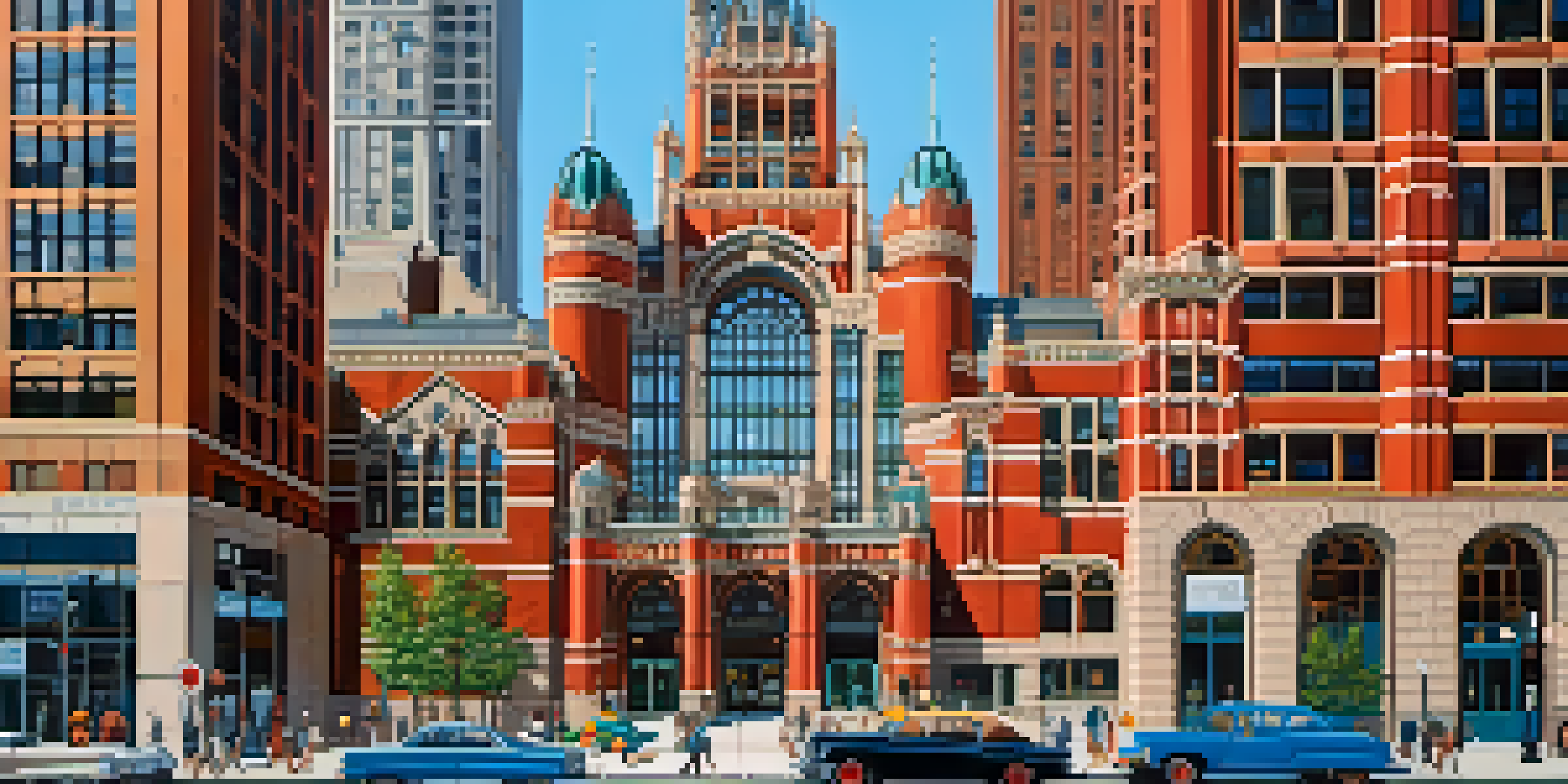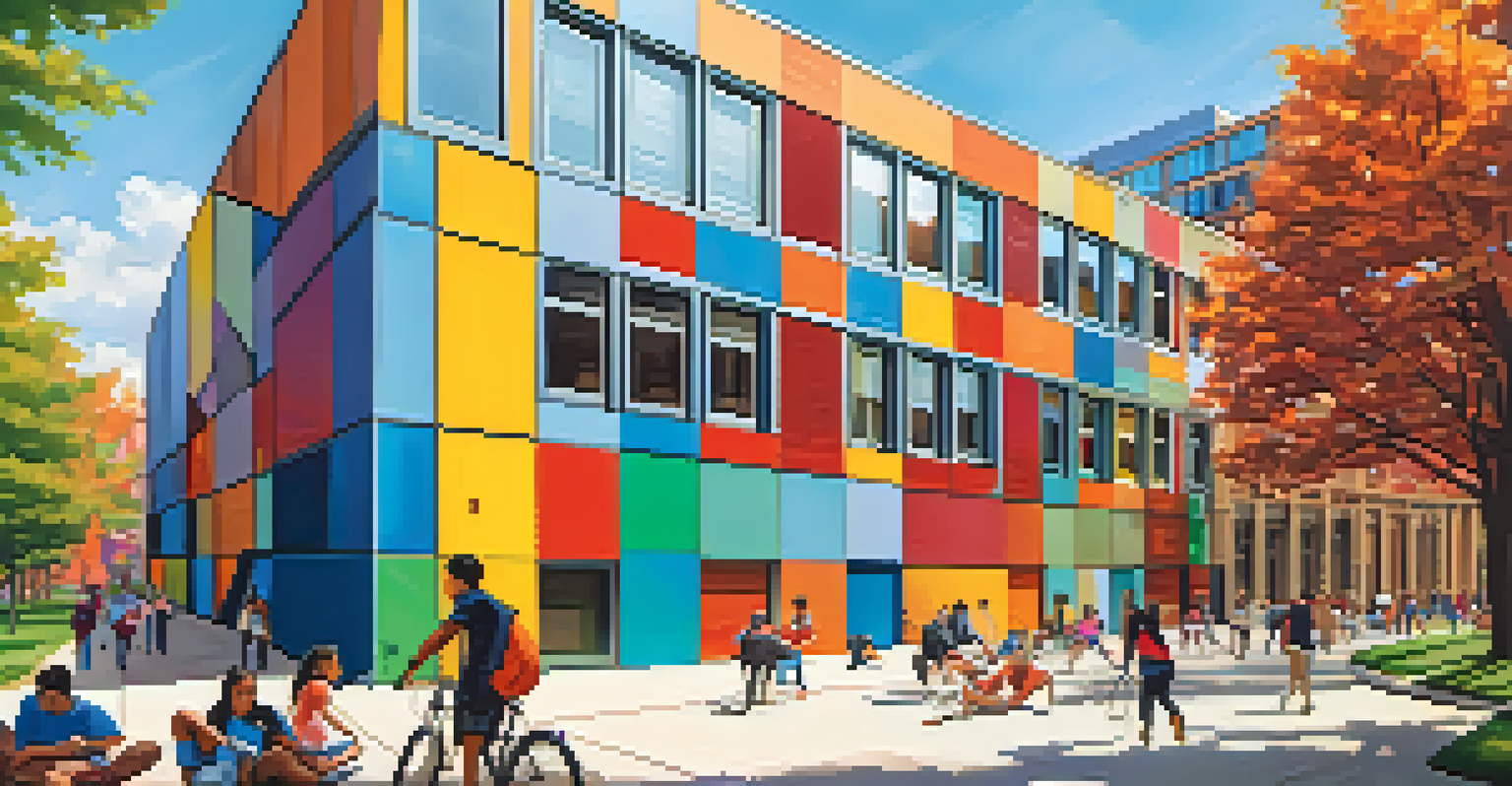Postmodern Architecture in Chicago: A Shift in Design Paradigm

Understanding Postmodern Architecture: A Brief Overview
Postmodern architecture emerged as a reaction against the austerity of modernism in the late 20th century. Unlike its predecessor, which favored minimalism and functionality, postmodern design embraces eclectic styles and historical references. This shift was not just about aesthetics; it also represented a broader cultural movement aiming to liberate architecture from rigid rules.
Architecture is the art of how to waste space.
In Chicago, the birthplace of modern architecture, the postmodern movement began to take root in the 1970s and 1980s. Architects began to play with forms, colors, and materials, creating buildings that were as much about expression as they were about purpose. This new approach allowed for greater creativity, leading to some of the most iconic structures in the city.
An example of this shift is the Harold Washington Library, completed in 1991. Its mix of brick and glass, along with its grand, detailed facade, stands in stark contrast to the sleek lines of modernist buildings. This embrace of variety and context is what defines postmodern architecture in Chicago.
Key Characteristics of Postmodern Architecture
Postmodern architecture is often characterized by its playful use of forms and historical references. You'll notice buildings that incorporate elements from various architectural styles, creating a sense of dialogue with the past. This might include decorative motifs, unconventional shapes, or even bright colors that stand out against the traditional skyline.

Another hallmark of postmodern design is the emphasis on context. Architects began to consider how their buildings fit within the surrounding environment, rather than imposing a singular vision. This resulted in structures that reflect local culture and history, making them more relatable to the community.
Postmodernism Redefines Architecture
Postmodern architecture emerged as a creative response to modernism, favoring eclectic styles and historical references.
Additionally, postmodern architecture often employs irony and humor, challenging the seriousness of modernism. This playful approach invites viewers to engage with the buildings in a more personal way, fostering a connection that goes beyond mere functionality.
Notable Postmodern Buildings in Chicago
Chicago is home to several notable examples of postmodern architecture that showcase this design philosophy. The AT&T Building, designed by Philip Johnson and John Burgee, features a distinctive Chippendale-style top that has become a recognizable landmark. Its playful form and classical references highlight the essence of postmodernism.
The best buildings are those that are used the most.
Another standout is the University of Illinois at Chicago's Academic and Residential Complex, designed by architect Walter Netsch. This building combines colorful facades with unique geometric shapes, creating a vibrant atmosphere that encourages interaction among students. Such designs push the boundaries of traditional educational architecture.
Lastly, the iconic James R. Thompson Center, designed by Helmut Jahn, exemplifies the transparency and boldness of postmodern architecture. Its glass and steel structure invites light and life into its public spaces, making it a lively hub in downtown Chicago.
The Role of Context in Chicago's Postmodern Movement
One of the defining aspects of postmodern architecture in Chicago is its strong connection to the city’s rich history and culture. Architects drew inspiration from the diverse architectural styles found throughout the city, blending them into their designs. This contextual approach demonstrates a respect for the past while also pushing for innovation.
For instance, the incorporation of local materials and references to historical buildings creates a sense of continuity within the urban landscape. The result is a tapestry of styles that reflect Chicago's evolution as a city, making each new structure a part of its ongoing story.
Context Shapes Chicago's Designs
Architects in Chicago use local culture and history to inform their designs, creating buildings that resonate with the community.
This contextual sensitivity also fosters a sense of community. Buildings that resonate with local history and culture invite residents and visitors to engage with them, creating spaces that feel familiar and welcoming. It's this relationship between architecture and the city itself that makes Chicago's postmodern landscape so compelling.
Cultural Influences on Chicago's Postmodern Architecture
Cultural shifts in the late 20th century greatly influenced postmodern architecture in Chicago. The rise of consumerism, the questioning of authority, and a growing emphasis on individual expression all played significant roles in shaping design choices. This cultural backdrop encouraged architects to explore new ideas and challenge traditional norms.
Moreover, the postmodern movement coincided with a time of social change. Issues such as urban renewal, gentrification, and environmental awareness began to emerge, prompting architects to consider the implications of their designs. This led to a greater emphasis on sustainability and community engagement in architectural practice.
Artists and designers often collaborated, merging art with architecture to create unique spaces. This interdisciplinary approach enriched the architectural landscape, resulting in buildings that are not only functional but also serve as cultural landmarks.
Criticism and Controversy Surrounding Postmodern Design
Despite its innovative spirit, postmodern architecture has faced criticism from various quarters. Detractors argue that the playful designs can sometimes lack coherence or depth, resulting in structures that feel superficial. This critique often points to the perceived emphasis on aesthetics over functionality, raising questions about the purpose of architecture in urban settings.
Additionally, some believe that the eclectic nature of postmodernism can create a disjointed cityscape, where buildings clash rather than complement one another. Critics often call for a return to more unified architectural principles, emphasizing the need for harmony in design.
Future Trends Embrace Sustainability
The future of postmodern architecture in Chicago is leaning towards sustainability and community engagement, addressing modern challenges.
However, supporters of postmodern architecture argue that its diversity fosters creativity and reflects the complexities of modern life. They contend that the variety of styles and expressions found in Chicago’s skyline is a celebration of individuality, capturing the spirit of the city and its inhabitants.
The Future of Postmodern Architecture in Chicago
As we look to the future, postmodern architecture in Chicago continues to evolve, adapting to new challenges and societal needs. Current trends indicate a growing emphasis on sustainability, with architects integrating green technologies and materials into their designs. This shift reflects a broader environmental consciousness that resonates with contemporary values.
Moreover, the conversation around community and inclusivity is influencing architectural practices. Designers are increasingly prioritizing spaces that foster social interaction and accessibility, ensuring that new developments resonate with a diverse population. This focus on community engagement is essential for creating vibrant urban environments.

Ultimately, the legacy of postmodern architecture in Chicago is likely to influence future designs. As architects draw inspiration from the past while embracing modern challenges, we can expect a continued blending of styles and philosophies that reflect the dynamic nature of the city and its people.